Parents of children with Autism, especially those with more severe challenges like language and sensory issues, often fret about embarking on toilet training. Questions about when to start and how to do it may linger and create anxiety. Also, as a child develops in personality and behavior, they are also changing physically, so it is important to remember the differences among kids and try not to compare your child to others. Your child’s readiness will depend on their own learned skills as well as developmental abilities such as muscle control.
The other half of the toilet training experience depends on the parent’s readiness. It takes time and energy to begin toilet training and may not always be an easy process. However, with some hard work and consistency from the child and parent, it can be done. Remember your goal; having an independent, happy child will be well worth the effort.
Signs that your child is ready to begin toilet training:
- Stays dry for longer periods of time
- Shows visible signs of urinating or having a bowel movement (e.g. squatting, pulling up pants, touching themselves, crossing legs)
- Shows interest or difference in behavior in response to seeing other people involved in toileting activities
- Ability to sit for about five minutes during an activity
- Can pull pants up and down with assistance
- Understands simple instructions (e.g. sit up or sit down)
What you need to begin Potty Training
- Regular toilet seat with insert – NO potty seats
- Charts (used to gather data on your child’s voiding patterns)
- Reinforcers (e.g. verbal praise, food, candy, drinks, toys, books, games, videos)
- Anything that your child likes or enjoys that, when given, increases the likelihood of that behavior happening again
- This is one of the most important elements to potty training. Without good reinforcement to motivate your child, your attempts may be unsuccessful.
- Training pants or kids’ underwear
- Time and patience
Potty Day
- Make a chart to track your child’s urination patterns
- This helps to determine how long your child is staying dry when they are more likely to urinate
- Arrange a fair amount of time to do nothing else but potty training
- Holidays and vacation time may be ideal
- Having two or three people available to help out may be beneficial
- Give your child plenty of liquids
- Place on potty from first waking moments for about three to five minutes
- Make it fun (e.g. blow bubbles, read stories, play games)
- Lessen time between potty sittings if there is an accident
- After a few hours, if successful, try putting training pants on your child
Picture Schedules
- Take pictures that will become the basis of your schedule
- Pictures of reinforcers that your child likes
- Pictures of the behaviors that earn the reinforcers (e.g. urinating, bowel movement, sitting on the toilet, washing hands, flushing toilet)
- Place pictures in a visible place at your child’s eye level (e.g. the bathroom door or wall).
- The first picture should be one your child already knows how to do
- Gradually add pictures of the more difficult tasks
Token Systems
- Chart your child’s urination by using a “potty chart”
- Child can earn candy after every time they use the potty
- Child can earn a star after every time they use the potty; after two stars they earn a piece of candy
- Remember to keep the chart visible to the child so they can see when they will earn the reinforcer.
- As the child makes progress, gradually expand the chart so they have to do three things to earn the reinforcement, then four, etc.
- You may need to start off using the chart for just part of the process. Add additional tasks (e.g. using the potty, then washing hands, then pulling up pants) as the child makes progress.




.png)
.png)
.png)


































